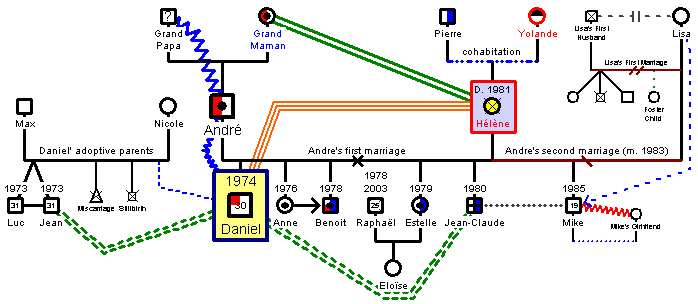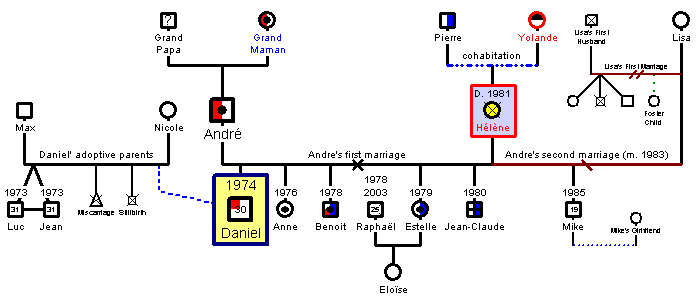Introduction to the Genogram
A genogram (pronounced: jen-uh-gram) is a graphic
representation of a family tree that displays detailed data on relationships
among individuals. It goes beyond a traditional family tree by allowing the user
to analyze hereditary patterns and psychological factors that punctuate
relationships. Genograms allow a therapist and his patient to quickly identify
and understand various patterns in the patient's family history which may have
had an influence on the patient's current state of mind. The genogram maps out
relationships and traits that may otherwise be missed on a pedigree chart.
Genograms were first developed and popularized in clinical settings by Monica
McGoldrick and Randy Gerson through the publication of a book in 1985. Genograms
are now used by various groups of people in a variety of fields such as
medicine, psychology, social work, genealogy, genetic research, and education.
There are many books and websites on the topic of genograms.
Genograms contain a wealth of information on the families represented. First,
they contain basic data found in family trees such as the name, gender, date of
birth, and date of death of each individual. Additional data may include
education, occupation, major life events, chronic illnesses, social behaviors,
nature of family relationships, emotional relationships, and social
relationships. Some genograms also include information on disorders running in
the family such as alcoholism, depression, diseases, alliances, and living
situations. Genograms can vary significantly because there is no limitation as
to what type of data can be included.
Basic genogram description video with example
The following video shows the basics of what a genogram is and uses the Star Wars Skywalker family as an example
What is a Genogram video
Genogram Example
 Sample Genogram with the Emotional Relationships (click to enlarge)
Sample Genogram with the Emotional Relationships (click to enlarge)
This genogram was created with GenoPro. You may click on
this link to get the sample genogram in larger
size. If you have GenoPro installed on your computer, you may open the file SampleGenogram.gno to get the interactive version. Spin the mouse wheel to
zoom-in and zoom-out. To begin, we can hide the emotional relationships by
clicking on the shaded happy face button in the toolbar
 .
The genogram shown below is the same as above, without the emotional
relationships.
.
The genogram shown below is the same as above, without the emotional
relationships.
 Sample Genogram without Emotional Relationships
Sample Genogram without Emotional Relationships
Interpreting a Genogram
This genogram contains a wealth of information. For the purpose of this
exercise, we will quickly overview the color codes and patterns inside the
squares and circles. These color codes are usually used to represent substance
abuse such as alcohol or drugs, and the patterns inside the gender symbol
usually represent a genetic disease. If you are
not doing a medical genogram, these symbols can
be reassigned to user-defined properties.
From the sample genogram above, you can see that males are represented by a
square and females are represented by a circle. All
genogram symbols are described here, and
the rules to interpret a genogram
are written here. The date of birth and/or date
of death are displayed on top of the gender symbol. In this genogram, Daniel was
born in 1974 and Hélène died in 1981. Raphaël was born in 1978 and died in 2003
at the age of 25. Due to the lack of space, the year of birth and year of death
are displayed on top of each other, but if you take a look at
this sample genogram, you will see the year of birth and year of death are
displayed horizontally "1978 - 2003". GenoPro can also display the full date of
birth and full date of death from the Display menu. Here is a summary of the
sample genogram:
- André has been married twice. His first marriage to Hélène ended in 1981
due to her untimely death. His first marriage date is not specified in this
genogram. In 1983, he married his second wife, Lisa.
- André is currently separated from Lisa, and according to the genogram, he is living
alone.
- Lisa was married to someone before marrying André. She gave
birth to triplets with one male stillbirth. Lisa and her first husband
became foster parents to a child. The couple eventually got divorced.
- Mike is André and Lisa's son. Mike has many half-siblings: Daniel, Anne,
Benoit, Estelle, Jean-Claude and Lisa's two surviving children.
- On the other end, Max and Nicole had identical twins in 1973. Later, Nicole had
a miscarriage and a stillbirth. The couple adopted Daniel. You can record
the date and place of an adoption on GenoPro by double-clicking on the
blue-dotted line.
The emotional relationships
provide an in-depth analysis of how these individuals relate to one another.
Here is a summary of the emotional relationships portrayed in the first sample:
- André was physically abused by his father. This violent behavior was
passed on, and André later emotionally abused his own son Daniel. Daniel had
a fused relationship with his mother. He now has a close relationship
(friendship) with Jean and his younger brother Jean-Claude.
- Hélène was very close (intimacy) to her mother in-law.
- Lisa and her first husband are estranged (cutoff). Lisa neglected her son Mike, and now Mike is
violent towards his girlfriend.
- Anne is focused (obsessed) on her younger brother Benoit.
- Jean-Claude is indifferent (apathetic) to his half-brother Mike.
- This genogram clearly illustrates that this family has many issues to deal with!
- The horizontal line between Luc
and Jean is an identical twins link, not the emotional relationship "plain /
normal". Click
here to get tips on how to tell an identical twins link apart from a
plain/normal relationship link.
Next: View Genogram examples